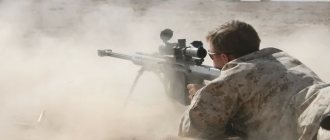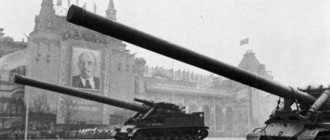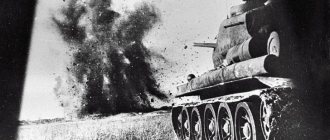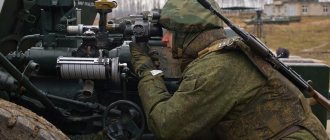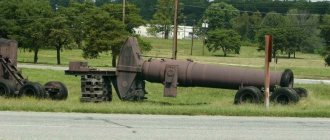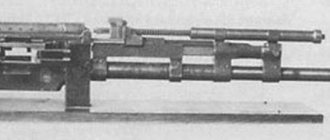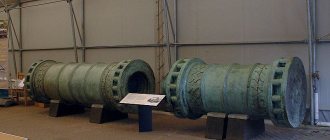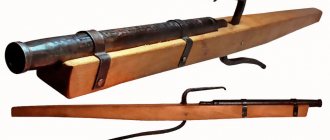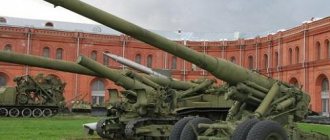| Parisian gun | |
| Type: | Super heavy rail weapon |
| A country: | German Empire German Empire |
| Service history | |
| In service: | German Empire |
| Wars and conflicts: | World War I |
| Production history | |
| Constructor: | Krupp |
| Manufacturer: | Krupp |
| Characteristics | |
| Weight, kg: | 256 000 |
| Length, mm: | 28 000 |
| Diameter, mm: | 210 |
| Elevation angle: | 55 degrees |
| Initial projectile speed, m/s | 1 600 |
| Sighting range, m: | 130 000 |
| Images on Wikimedia Commons: | Parisian gun |
K:Wikipedia:Articles without images (type: not specified)
Parisian gun(German)
Paris-Geschütz
), also known as
"Kaiser Wilhelm Trumpet"
(German)
Kaiser-Wilhelm-Rohr
) And
"Colossal"
(German)
Kolossal
, not to be confused with the German tank of the same name of the same period) is an ultra-long-barreled 210 mm gun on a rotating carriage. With the help of this weapon in 1918, German troops shelled Paris.
The gun entered service with the German Empire in March 1918 and was used only until August of the same year - the destructive power of the installation was insignificant, the gun barrel had to be replaced frequently, and the shooting accuracy was only sufficient to hit a projectile within the city. The effect of using the gun was rather psychological - shelling from such a long-range gun greatly reduced the morale of the Parisians, and the presence of a grandiose device inspired the German troops.
Description
There is no detailed information regarding the design features and capabilities of the gun, and most of the available data is very approximate - even the exact number of shots fired by the gun is unknown.
The gun was manufactured at Krupp factories. The 210 mm barrel was 28 m long (that is, more than 130 calibers) and was equipped with an additional 6-meter smoothbore extension installed at its output end. The gun complex weighed 256 tons and was mounted on a railway platform specially designed for this purpose. The mass of the projectile is about 120 kg, the powder charge is 200 kg, the firing range is 130 km, the initial velocity of the projectile is about 2000 m/s (≈ 5), the maximum trajectory height is up to 45 km. The high-speed movement of the projectile through the stratosphere was one of the main factors in the gun's unique range, thanks to a significant reduction in air resistance.
Since naval gunners had more experience in using large guns, control of the cannon was placed in the hands of sailors. The gun crew consisted of 80 sailors under the command of the admiral. The gun was camouflaged in the forest, several batteries of smaller caliber were placed around it, creating a “noise background” in order to misinform the enemy and prevent him from calculating the location of the “Paris Cannon”. The projectile's flight time to the target was about three minutes.
The relatively thin trunk weighing 138 tons sagged under its own weight, so it was supported by a special cable system. After the shot, the transverse vibrations of the barrel continued for 2-3 minutes. The barrel life was no more than 65 shots. Due to the high power of the charge and the initial speed of the projectile, each shot wore out the walls of the barrel so much that the caliber of the gun became significantly larger each time. Therefore, a set of numbered shells was made for each barrel, each of which was slightly larger in caliber than the previous one. The shells were fired in a strict sequence, and after the set was used up, a scheduled replacement of the barrel was carried out. Worn barrels were drilled to larger calibers (224 and 238 mm) and used again. The pressure in the barrel and, accordingly, the firing range decreased.
Kaiser Wilhelm's Paris Gun
Like many other realized utopian ideas, the supergun faced an unenviable fate: the Germans destroyed all the guns and technical documentation immediately after the conclusion of peace, which automatically relegated it to the category of legends.
The difficult origins of the Colossal gun began in 1916, when Professor Eberhardt came to the design headquarters of the Krupp plant with a proposal to create a cannon that could fire at 100 km. Theoretically, the professor’s calculations showed that the enemy should be hit with 100-kilogram shells with an initial speed of 1600 m/s. The unpleasant air resistance was supposed to be overcome by sending the projectile to the heights of the upper boundary of the stratosphere (about 40 km), where the rarefied air envelope increased the firing range. Three-quarters of the projectile’s flight to the target had to take place precisely in the stratosphere - for this, Eberhardt proposed raising the barrel of the gun by an angle of at least 500. It is noteworthy that in his project the professor even took into account the correction for the rotation of the Earth, vitally necessary for artillerymen taking into account the time of the projectile’s approach to the target. goals. The German elite, together with Krupp industrialists, believed Eberhardt and set him 14 months to produce a cannon to destroy Paris. It is worth making a small patriotic digression and pointing out the project of an ultra-long-range gun (more than 100 km), proposed by the Russian military engineer V. M. Trofimov back in 1911, which, as happened more than once, was rejected.
Ultra-long-range cannon "Colossal". Source: secrethistory.su
The practical implementation of the German ultra-long-range gun was carried out by the Krupp plant in Essen (under the supervision of director Rausenberg) and at the very beginning of the project the choice was made in favor of ready-made barrels of 35-cm naval guns, which, with minor modifications, were to become the basis of Kaiser Wilhelm's future Paris gun. However, while the prototype was being designed, by 1916 the Germans planned to withdraw to the Siegfried Line at a distance of 110 km from Paris. Ludendorff eventually demanded that the range of the gun be increased to 128 km. Of course, a 35-centimeter barrel was not enough for such a range and the Kruppites turned their attention to the battleship caliber of 38 cm. Such powerful guns under the symbol SK L/45 were originally planned for battleships such as Bayern, Sachsen and Wurtemberg. In the field version, the gun received the name Langer Max (Long Max) and distinguished itself during the shelling of Dunkirk at a record range of 47.5 km. The Long Max fired a projectile weighing 213.5 kg with a muzzle velocity of 1040 m/s, which made it an excellent base for the future Colossal. Rausenberg intended to increase the barrel length and thereby accelerate the projectile for Paris to the required 1600 m/s, however, a technological problem arose. Krupp machines in those days were unable to cut threads in barrels longer than 18 m, so the connecting flange came to the rescue. With its help, smooth-walled extension nozzles of two sizes were attached to the rifled barrel of the “Long Max” - 3.6 and 12 meters. Such a super-barrel in its basic version reached 34 meters in length, of which 1 m was for the breech, 3 m for the charging chamber, 18 m for the rifled barrel and the rest for the innovative attachment. Of course, the trunk was bent under the force of its own gravity - this sharply reduced the chances of getting into the French capital, so they developed a special cable support system like a bridge. Eyewitnesses claimed that the vibrations of the barrel after each shot lasted two to three minutes. Due to the use of a replaceable liner (rifled pipe inserted into the barrel of large-caliber artillery guns), which preserves the gun from extreme pressures and temperatures, the caliber of the Colossal was 21 cm.
One of the few “lifetime” photos of the gun. Source: zonwar.ru
The cannon fired its first shots in the summer of 1917 in the city of Mappen - the shells flew towards the sea, but only reached a 90-kilometer range. Engineers determined the reason was the weak seal of the projectile in the smoothbore nozzle and went to Essen to refine the gun. As a result, new projectiles were introduced with 64 ready-made lugs on two leading belts, ensuring good guidance of the projectile along the rifling. The problem of weak obturation on the smooth part of the barrel was solved by the design “highlight” of the leading belts, which, coming out of the rifled part, rotated under the influence of a moment of force and locked the barrel bore. Each projectile was very expensive, so the Germans decided to guarantee its detonation on the target by installing two fuses at once - a bottom one and a diaphragm one. And, indeed, all the shells from the Colossal fired into French territory exploded, but some did not do so completely. Carefully collected large fragments allowed us to get an idea of the design of the supergun projectile. It is noteworthy that the Germans took into account the degree of wear of the Colossal liner and all the shells had different calibers - from 21 cm to 23.2 cm. Also, each of them had its own serial numbers and the latest (and, accordingly, the largest) were already drilled liner after 50-70 shots.
21 cm "Colossal" projectile with ready-made protrusions. Source: News of the Russian Academy of Missile and Artillery Sciences
Due to the peculiarities of firing from a gun, the mass of the charge was variable: the main part was 70 kg, enclosed in a brass sleeve; the silk cap contained 75 kg of gunpowder in the middle part of the charge and, finally, the front part - it was its mass that was selected based on specific conditions. For example, on the cool day of the debut shelling of Paris, 50.5 kg was immediately sent to the front of the charge, based on calculations for a higher air density. In total, for each shot the artillerymen used up to 200 kg of high-grade gunpowder with a projectile weight of 104 kg. The gunpowder was a special grade RPC/12 and was distinguished by its relatively slow burning in order to increase the survivability of the barrel.
The body of the projectile with a serial number. Source: News of the Russian Academy of Missile and Artillery Sciences
Approximate calculations of the external ballistics of the Colossal, carried out at the Russian Academy of Rocket and Artillery Sciences, show that the maximum flight altitude of the projectile was 37.4 km, to which it climbed in 84.2 seconds. With a muzzle velocity of 1600 m/s, the further climb proceeded with a slowdown in flight, however, on the downward part of the trajectory the projectile accelerated to a second maximum speed of 910 m/s. Then it slowed down again due to friction with the dense layers of the atmosphere and flew towards the French at an angle of 54.10 at a speed of 790 ms/s. The time from the shot to the fall of the projectile was a painful 175 seconds.
Firing table for 21 cm projectile. Source: News of the Russian Academy of Missile and Artillery Sciences
The Germans attacked Paris during the First World War, installing the Colossal on a circular rail track, allowing the gun to be aimed in azimuth. The total weight of the installation exceeded 750 tons, and for the concrete base of the carriage it took over 100 tons of cement, 200 tons of gravel and a couple of tons of reinforcement. “Land” artillerymen were not allowed to service such a monster, but 60 naval and coastal artillery gunners who had experience working with such “toys” were dispatched. The gun batteries were located at three points - at a distance of 122, 100 and 80 km from Paris. The most distant battery, camouflaged in a dense forest near the town of Laon, thundered first, and did so with the support of sound-masking guns. The latter were supposed to fire synchronously with the Colossals to mislead the French sound-metric reconnaissance stations. The Germans approached the artillery raid on Paris very thoroughly - an intelligence network in the French capital monitored the effectiveness of the attacks, and aerial bombing of the city was stopped altogether for the sake of the purity of the experiment. The Kaiser's supercannons fired at the target for 44 days from March 23, 1918, firing 303 shells and killing 256 people - less than one Parisian per 100 kg piece of steel with explosives. Moreover, only 183 shells flew into the city limits, the rest exploded in the vicinity of Paris. The statistics would have been even less optimistic if a shell had not hit St. Church on March 29. Gervais, taking 88 people to the next world and maiming 68. There was also a certain psychological effect from “Colossal” - several thousand French left the city, not feeling protected from an accidental arrival. Realizing the uselessness of such expensive guns, the Germans took them out of the occupied territory, dismantled them, and destroyed all documentation. It is not known whether they did this out of shame or for reasons of secrecy, but after some time the concept of ultra-long-range guns again captured the brains of German designers. And they implemented this on a much larger scale.
Shelling of Paris
The first shot was fired at Paris on March 21, 1918. The mysterious explosions caused confusion and panic among Parisians, as they occurred suddenly and for unknown reasons. However, the destruction in general was not very significant - the most notable episode of the summer shelling was a direct hit on the Church of Saint-Gervais, where a service was going on at that moment - more than 60 people were killed. In total, according to various sources, 320-370 shots were fired at Paris, killing 250 and wounding 620 people. R. Rolland's story “Pierre and Luce” (English) Russian [1] is dedicated to this event.
After the start of the Entente offensive in August 1918, the “Paris Cannon” was evacuated to Germany and destroyed to avoid capture by enemies. Only a small part of the details were preserved, which were later found by the Americans near Chateau-Thierry.
Technology - youth 1987-03, page 41
jgp
Collective consultant: Central Museum of the Armed Forces of the USSR. The author of the article is Doctor of Technical Sciences, Professor V. G. MALIKOV. Artist - V. I. BARYSHEV.
"PARISIAN" GUN
The night of March 23, 1917 passed without the sound of sirens announcing another air raid. However... “at 7 o’clock in the morning I heard a powerful, as it seemed to me, bomb explosion that shook the windows of our apartment on Quai Bourbon,” recalled Lieutenant General A. A. Ignatiev, at that time the Russian military attache in France.— The sirens were silent, and we were even more surprised when exactly at 7:15 a.m. the same blow was heard, and at 7:30 a.m. a third, somewhat more distant one. On this sunny morning, Paris froze from the continuing and incomprehensible strong explosions of some unknown bombs.” These were shells fired from ultra-long-range German guns.
The idea to subject Paris to artillery fire, thereby demonstrating its military power, and to exert a moral influence on the French, arose at the Kaiser's headquarters in the spring of 1916. On the initiative of General E. Ludendorff, it was decided to produce a large-caliber cannon that could reach Paris from behind the front line, which was then 90 km from the capital of France.
The development of the gun was entrusted to the Krupp company, which in 1914 produced a naval gun that fired at a range of 56 km.
20 km, and after 90 s it reached the top of the trajectory - 40 km. Then the projectile re-entered the atmosphere and, accelerating, hit the target at a speed of 922 m/s. He completed the entire flight over a distance of 150 km in 176 s.
The first shell fell on Republic Square. In total, the Germans fired 367 shells across the French capital, with a third of them hitting the suburbs. 256 Parisians died, 620 people were wounded, but the Kaiser’s command never achieved the goal set by Ludendorff. On the contrary, in July - August 1918, the Allies launched offensive operations that brought Germany to the brink of defeat.
True, several hundred citizens left Paris. Rumors began to spread about the mysterious “Big Bertha” supercannon, supposedly named after A. Krupp’s wife. Let’s be clear - “Big (or “Fat”) Bertha” was the name given to the short-barreled, 420-mm siege mortar that the German army used during the siege of the Belgian fortress of Liege (see “TM” No. 2 for 1987). And three ultra-long-range 210-mm Colossal cannons fired at the French capital. After signing a truce with the allies, push-
Notes
- Commentaries on Russian translations of the story erroneously indicate that the church was destroyed by an air bomb.
| This is a draft article about artillery. You can help the project by adding to it. |
| Design |
|
| Unique personalized weapons |
|
| Classification | |
| |
[/td]
|
|
|
|
| Mortars and mortars | 7.58 cm leMW 9.15 cm leichtes Minenwerfer System Lanz 17 cm mMW schwerer 24 cm Flügelminenwerfer “Iko” 25 cm sMW Albrecht mortar |
| Field, medium and heavy artillery | 7.7 cm FK 96 7.7 cm FK 96 nA 7.7 cm FK 16 7.7 cm KiH 10.5 cm FH 98/09 10.5 cm leFH 16 10 cm K 04 10 cm K 14 10 cm K 17 13.5 cm K 09 · 15 cm L/40 Feldkanone iR · 15 cm sFH 02 · 15 cm sFH 13 · 15 cm Kanone 16 · 17 cm SK L/40 iRL |
| Super-heavy and siege artillery | 21 cm Mrs.10 · 21 cm Mrs.16 · " Paris Gun " · 28 cm Haubitze L/12 · 38 cm Langer Max · 42 cm Gamma Mörser · "Big Bertha" |
| Railway artillery | 15 cm SK "Nathan" · 17 cm SK L/40 "Samuel" · 21 cm SK "Peter Adalbert" · 24 cm SK L/30 "Theodor Otto" · 24 cm SK L/40 "Theodor Karl" · 28 cm SK L/40 "Bruno" · 28 cm KL/40 "Kurfürst" · 38 cm SK L/45 "Max" |
An excerpt characterizing the Parisian gun
- Still alone, without my friends... And he wants me not to be afraid. Her tone was already grumbling, her lip lifted, giving her face not a joyful, but a brutal, squirrel-like expression. She fell silent, as if finding it indecent to talk about her pregnancy in front of Pierre, when that was the essence of the matter. “Still, I don’t understand, de quoi vous avez peur, [What are you afraid of," Prince Andrei said slowly, without taking his eyes off his wife. The princess blushed and waved her hands desperately. “Non, Andre, je dis que vous avez tellement, tellement change... [No, Andrei, I say: you have so, so changed...] “Your doctor tells you to go to bed earlier,” said Prince Andrei. - You should go to bed. The princess said nothing, and suddenly her short, whiskered sponge began to tremble; Prince Andrei, standing up and shrugging his shoulders, walked around the room. Pierre looked in surprise and naively through his glasses, first at him, then at the princess, and stirred, as if he, too, wanted to get up, but was again thinking about it. “What does it matter to me that Monsieur Pierre is here,” the little princess suddenly said, and her pretty face suddenly blossomed into a tearful grimace. “I’ve been wanting to tell you for a long time, Andre: why did you change so much towards me?” What I did to you? You're going to the army, you don't feel sorry for me. For what? - Lise! - Prince Andrey just said; but in this word there was a request, a threat, and, most importantly, an assurance that she herself would repent of her words; but she continued hastily: “You treat me like I’m sick or a child.” I see everything. Were you like this six months ago? “Lise, I ask you to stop,” said Prince Andrei even more expressively. Pierre, who became more and more agitated during this conversation, stood up and approached the princess. He seemed unable to bear the sight of tears and was ready to cry himself. - Calm down, princess. It seems so to you, because I assure you, I myself experienced... why... because... No, excuse me, there is no stranger here... No, calm down... Goodbye... Prince Andrei stopped him by the hand. - No, wait, Pierre. The princess is so kind that she will not want to deprive me of the pleasure of spending the evening with you. “No, he only thinks about himself,” said the princess, unable to hold back her angry tears. “Lise,” said Prince Andrei dryly, raising his tone to the degree that shows that patience is exhausted. Suddenly the angry, squirrel-like expression of the princess’s beautiful face was replaced by an attractive and compassion-arousing expression of fear; She glanced from under her beautiful eyes at her husband, and on her face appeared that timid and confessing expression that appears on a dog, quickly but weakly waving its lowered tail. - Mon Dieu, mon Dieu! [My God, my God!] - said the princess and, picking up the fold of her dress with one hand, she walked up to her husband and kissed him on the forehead. “Bonsoir, Lise, [Good night, Liza,” said Prince Andrei, getting up and politely, like a stranger, kissing his hand. The friends were silent. Neither one nor the other began to speak. Pierre glanced at Prince Andrei, Prince Andrei rubbed his forehead with his small hand. “Let’s go have dinner,” he said with a sigh, getting up and heading to the door. They entered the elegantly, newly, richly decorated dining room. Everything, from napkins to silver, earthenware and crystal, bore that special imprint of novelty that happens in the household of young spouses. In the middle of dinner, Prince Andrei leaned on his elbow and, like a man who has long had something on his heart and suddenly decides to speak out, with an expression of nervous irritation in which Pierre had never seen his friend, he began to say: “Never, never get married, my friend; Here's my advice to you: don't get married until you tell yourself that you did everything you could, and until you stop loving the woman you chose, until you see her clearly; otherwise you will make a cruel and irreparable mistake. Marry an old man, good for nothing... Otherwise, everything that is good and lofty in you will be lost. Everything will be spent on little things. Yes Yes Yes! Don't look at me with such surprise. If you expect something ahead from yourself, then at every step you will feel that everything is over for you, everything is closed, except for the living room, where you will stand on the same level as a court lackey and an idiot... What!... He energetically waved his hand . Pierre took off his glasses, causing his face to change, showing even more kindness, and looked at his friend in surprise. “My wife,” continued Prince Andrei, “is a wonderful woman.” This is one of those rare women with whom you can be at peace with your honor; but, my God, what I wouldn’t give now not to be married! I’m telling you this alone and first, because I love you. Prince Andrei, saying this, looked even less like than before that Bolkonsky, who was lounging in Anna Pavlovna’s chair and, squinting through his teeth, spoke French phrases. His dry face was still trembling with the nervous animation of every muscle; the eyes, in which the fire of life had previously seemed extinguished, now shone with a radiant, bright shine. It was clear that the more lifeless he seemed in ordinary times, the more energetic he was in these moments of almost painful irritation. “You don’t understand why I’m saying this,” he continued. – After all, this is a whole life story. You say Bonaparte and his career,” he said, although Pierre did not talk about Bonaparte. – You say Bonaparte; but Bonaparte, when he worked, walked step by step towards his goal, he was free, he had nothing but his goal - and he achieved it. But tie yourself to a woman, and like a shackled convict, you lose all freedom. And all that you have of hope and strength, everything only weighs you down and torments you with remorse. Living rooms, gossip, balls, vanity, insignificance - this is a vicious circle from which I cannot escape. I am now going to war, to the greatest war that has ever happened, but I know nothing and am no good for anything. “Je suis tres aimable et tres caustique, [I am very sweet and very eater,” continued Prince Andrei, “and Anna Pavlovna listens to me.” And this stupid society, without which my wife and these women cannot live... If only you could know what it is toutes les femmes distinguees [all these women of good society] and women in general! My father is right. Selfishness, vanity, stupidity, insignificance in everything - these are women when they show everything as they are. If you look at them in the light, it seems that there is something, but nothing, nothing, nothing! Yes, don’t get married, my soul, don’t get married,” Prince Andrei finished.
